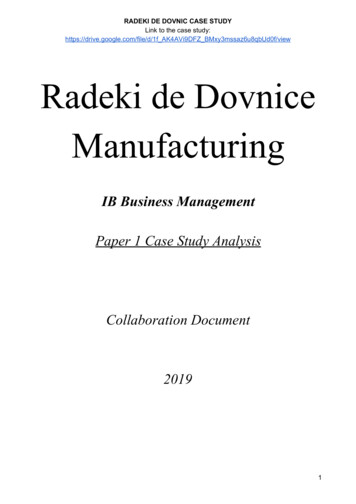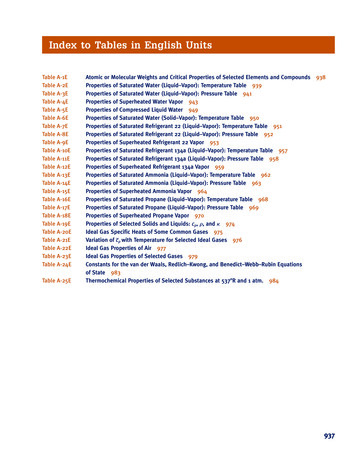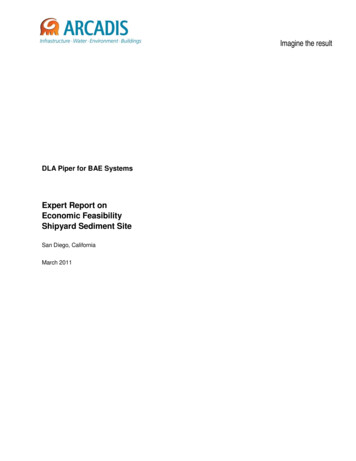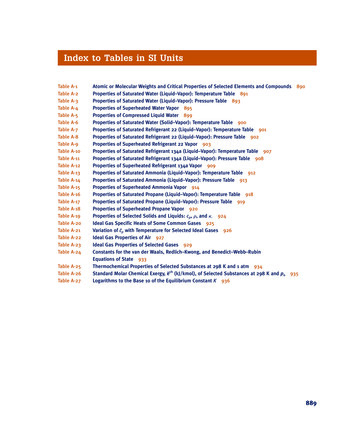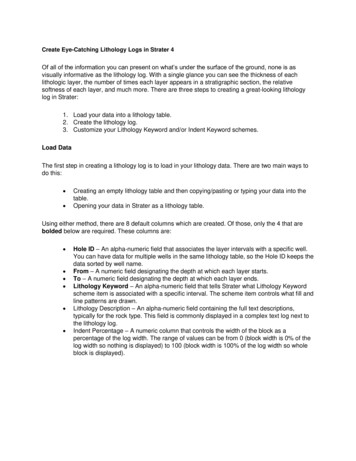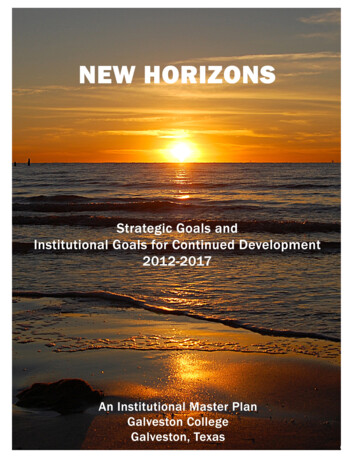
Transcription
TABLE OF CONTENTSFOREWORD . 1MISSION . 3PURPOSES . 3PHILOSOPHY . 4VISION . 4VALUES . 4INTRODUCTION . 5THE GOALS PROCESS . 6STRATEGIC GOALS . 7GOALS FOR THE CONTINUED DEVELOPMENT OF GALVESTON COLLEGEEDUCATION AND CURRICULUM . 8FACILITIES . 11FINANCIAL . 12INSTITUTIONAL AND MANAGEMENT . 13PERSONNEL . 15STUDENT SERVICES . 16THE GOALS ACHIEVEMENT RESPONSIBILITY MATRIX . 18FINAL REVIEW – INSTITUTIONAL MASTER PLAN 2007-2012 . 25THE PEOPLE OF GALVESTON COLLEGE . 35
FOREWORD: A Message from the PresidentGalveston College has experienced a significant number of developments and changessince the publication of its institutional master plan in 2007. Following the developmentand implementation of the plan, Hurricane Ike struck Galveston in 2008. And then in2011, the College experienced significant budgetary challenges as a result of the Stateof Texas’s inability to continue to fund community colleges at rates comparable to prioryears. Through it all, the College followed its institutional master plan, using theidentified short term and long-term goals, as well as specific strategies and activities toimprove the College, improve student success, grow fundable institutional contacthours, and to expand educational opportunities to an increasingly diverse service area.Some of the notable achievements since 2007 include:1. The placement of graduates from our vocational-technical programs is amongthe best in the state.2. Our students who transfer to four-year institutions continue to be rankedcomparably to native four-year students.3. The faculty and staff continue to upgrade and improve their skills through anactive professional development program.4. Seventy percent or more of all classes and all contact hours were taught by fulltime faculty.5. Student enrollment and fundable contact hours increased between 2007 and2012 through increased recruiting efforts and increased fall to spring retentionrates.6. Students entering developmental studies are increasingly demonstratingreadiness for gatekeeper courses and success in demonstrating collegereadiness.7. As enrollment and persistence to graduation has increased, the number ofcertificates and degrees awarded has reached an all-time high.8. The core curriculum was revised and updated; field of study curriculums wereadopted in Business Administration, Computer Science, Criminal Justice,Education, Nursing, and Speech; and, revised and updated degree plans wereadopted for all disciplines.9. New programs were established in Pharmacy Technology, Welding, Heating andAir Conditioning, and Industrial Systems.10. Computer learning labs were established for Developmental Mathematics and forDevelopmental Reading and Writing.11. Distance education programs were updated and expanded with the adoption ofonline associate degrees, as well as online certificates in ComputerizedTomography (CT) and Magnetic Resonance Imaging Technology (MRI), andAngel Learning (a course management system).12. All college classrooms were converted and established as ‘smart classrooms.’13. The Cheney Student Center was remodeled and opportunities for studentsexpanded with the addition of the 10,000 sq ft Abe and Annie Seibel Wing.1
14. The College completed the purchase of a 4.3 acre site on Broadway for thedevelopment of a new vocational-technical training center. Further, the Collegeopened Phase I of the project with 20,000 sq ft of renovated space for newtechnical programs in the Fall of 2010.15. Parking for students and faculty was improved with the repaving of the MoodyHall parking lot and the development of the Avenue Q parking lot.16. The College’s main campus was expanded as the last of the houses in theblocks defined by 39th and 41st Streets and Avenues Q and R were purchased.17. The three campus chillers were replaced with three new energy efficient chillers.18. The College was awarded ‘hold harmless funding’ following Hurricane Ike, andthe College expanded the use of grant funds with grants such as Title V,Building Bridges for Success, Upward Bound, Perkins, ARRA, SSBG, HEDR,and the newest of the grants, a Title V STEM grant.19. A new ERP system was implemented with the installation and development ofthe Datatel Colleague system that included new modules for admissions,registration, online registration, degree audit, early alert, financial aid, studentaccounting, finance, and a new student portal.20. The College’s emergency management and disaster recovery plan, along withthe emergency alert system, were revised and updated.21. Competitive salaries for faculty and staff were maintained.22. The College remains financially sound with the ability to take on various projectson a pay-as-you-go basis, including such projects as the development of the newvocational-technical center, the purchase of new chillers, and the development ofthe new ERP system.It is important, however, that we not rest on our laurels. It is fitting that we lookforward to the future, set our goals, and prepare the College as we prepare our studentsfor the 21st Century. Our new institutional master plan, New Horizons, will help prepareGalveston College to meet the challenges that lie ahead and allow us to help studentssucceed.Many individuals have worked diligently to formulate the goals set forth in thisstudy. It sets before us a profound challenge and makes public a dream of what wemay yet achieve. The goals it contains have been considered by the collegecommunity: They are our goals, our ambitions, and they are worthy of our best efforts.W. Myles SheltonPresident2
GALVESTON COLLEGEAN INSTITUTIONAL MASTER PLAN2012-2017MissionGalveston College, a comprehensive community college committed to teaching andlearning, creates accessible learning opportunities to fulfill individual and communityneeds by providing high-quality educational programs and services.PurposesThe purposes of Galveston College are defined in the Texas Education Code, Section130.003, and shall be to provide:(1)technical programs up to two years in length leading to associate degreesor certificates;(2)occupational programs leading directly to employment in semi-skilled andskilled occupations;(3)freshman and sophomore courses in arts and sciences;(4)continuing adult education programs for occupational or culturalupgrading;(5)compensatory education programs designed to fulfill the commitment ofan admissions policy allowing the enrollment of disadvantaged students;(6)a continuing program of counseling and guidance designed to assiststudents in achieving their individual educational goals;(7)workforce development programs designed to meet local and statewideneeds;(8)adult literacy programs and other basic skills programs for adults; and,(9)such other purposes as may be prescribed by the Texas Higher EducationCoordinating Board or the Galveston College Board of Regents, in thebest interest of post-secondary education in Texas.Galveston College exists to serve these purposes as they relate first to the local serviceareas, then to the State of Texas, and finally, to the nation. Further, Galveston Collegeaccepts the challenge of providing the resources, curricula, instructional support, andpersonnel required to best serve the many educational needs of its students.3
PHILOSOPHY OF GALVESTON COLLEGEThe faculty, staff, Board of Regents, and administrators at Galveston College arecommitted to the concept that our College be an open door to learning. With this goal inmind, we extend an educational opportunity to students of all ages who can profit frominstruction.Every effort is made to provide equal access to the educationalopportunities offered at Galveston College without regard to age, gender, color, nationalor ethnic origin, race, religion, creed, and/or disability.In keeping with this philosophy, Galveston College recognizes and accepts theresponsibility for providing curricula for university-bound students, for students seekingcareer opportunities in a variety of occupations, and for persons of the communityseeking cultural enrichment, short-term skill training, or personal improvementopportunities. The College will seek to achieve these goals within the limits of its legalresponsibilities and available fiscal resources.VisionGalveston College: A beacon of light guiding life-long learning.ValuesThe Board of Regents developed a list of seven values as an integral part of the CollegeMission and Vision. The values reinforce the Board‟s desire to provide ethicalleadership and are used in making decisions undertaken by the college community asthe Mission is operationalized. From the development of unit goals to the simplestactions and decisions taken by college staff, these values will manifest AccessAchievement4Respect
INTRODUCTIONThe 2007-2012 Institutional Master Plan was a statement of common hopes anddreams for Galveston College. This document and evaluation documents that support itrepresent the completion of a five year master planning and evaluation cycle atGalveston College. New Horizons sets forth a new set of hopes and new dreams forthe Galveston College community. New Horizons is based on a three-phase processthat includes setting goals, developing plans to achieve them, and monitoring thesuccess of goal achievement, which includes feeding information back into the planningprocess. The process was undertaken by the College faculty, the Regents, theadministration, the staff, and the community in an effort to help people within theCollege and in the surrounding community achieve five important results:To help us better understand the College's needs, opportunities, and resources,and how they are related;To help us resolve our individual opinions into a consensus of what we should bedoing and where we should be headed;To help all of us become more involved in the College decision-making system ina productive manner;To help us develop a greater sense of confidence about the College, a cleareridea of our collective aspirations, and a positive feeling of momentum forachieving our goals; andTo develop within the institution a greater sense of community, of belonging, ofbeing part of what happens at Galveston College.There are other functions intended for this plan. It will be reviewed on an annualbasis by the College community to determine progress toward achieving our goals.Another purpose is to serve as a source of information and as a guide to anyoneinterested in the betterment of Galveston College. In this role, it is hoped this plan willencourage comment, creative ideas, and dialogue not only within the College, but alsowithin the supporting community. For this reason, it will be disseminated to allinterested persons and organizations within the service area. It is hoped that eachreader will want to become involved with us in bringing the goals to reality.5
THE GOALS PROCESSThe goals process for the five-year master plan at Galveston College is a threephase approach to institutional planning involving a goal-setting phase, a phase fordeveloping plans and achieving the goals, and a monitoring and evaluation phase thatinforms the annual planning process.The Goal Setting PhaseNew Horizons represents the completion of the first phase of the institutionalplanning process for 2012-2017. During the academic year 2011-2012 the faculty, thestaff, the administration, the Galveston College Board of Regents, and members of thecommunity held workshops and developed a list of needs and concerns. These needsand concerns were reviewed and refined and from this list of needs and concerns a setof goals was developed for consideration by the College.After initial work on the goals was completed, the final process of refining thegoals began. The refinement of goals was completed by the various departmentsresponsible for the goals and the administrative staff. The goals for Galveston Collegefor 2012-2017 were approved and adopted by the Galveston College Board of Regents.The Planning and Achievement PhaseDuring Spring and Summer of 2012, the second phase of the process wasinstigated. Action plans for each goal were set forth. Action plans include specificobjectives or strategies, expected outcomes, establishment of metrics for assessment,assignment of responsibility, timetables, and budgetary requirements.The Monitoring and Evaluation PhaseThe administrative staff and the Institutional Effectiveness Committee will monitorand evaluate institutional movement toward goal completion. Each year a status reportwill be prepared showing the progress made toward achieving each goal identified.Also, new goals will be formulated as new needs are identified and old ones are met.The plans developed to achieve each goal will be evaluated periodically and modifiedas needed. This information will be fed into the overall planning of the College as partof the "feed-back loop."6
GALVESTON COLLEGESTRATEGIC GOALS1.Provide dynamic programs of study and conduct appropriate cultural activities tomeet the needs of a diverse student body that is reflective of the community andservice area constituents so that constituents will be prepared to compete in aglobal economy.2.Provide comprehensive student support services that enhance student success.3.Provide effective recruitment and retention processes.4.Provide a qualified and diverse faculty and staff through fair hiring processes andcontinuous professional development.5.Provide facilities and grounds that create a physical environment conducive toteaching and learning in the 21st Century.6.Provide and continuously improve technology to collect and store data, providerequired information, support learning needs, and facilitate effectivecommunications.7.Provide effective and accountable management of resources.8.Seek additional resources to support the mission of the College.9.Conduct and document comprehensive institutional research, planning, andinformation services that support continuous improvement of every facet ofcollege operations.10.Meet all federal, state, local, and accreditation agency accountability standardsfor operations and quality.7
EDUCATION AND CURRICULUM DEVELOPMENT GOALSIn support of the College‟s mission, a variety of curricula choices are offered that aredesigned to serve diverse communities and prepare the student for a successful futurein the 21st Century. Galveston College is committed to continuous improvement of theteaching and learning process through revisions of the curriculum and enhancements ofinstructional resources while remaining focused on student success. Our education andcurriculum development goals in support of the mission, student success, and improvingthe teaching and learning process for 2012-2017 follow:OPERATIONAL GOALS / ACTIONS FOREDUCATION AND CURRICULUM DEVELOPMENT1.Evaluate, revise, and expand academic course and program offerings, asappropriate.a.b.c.d.e.f.g.Revise and update the Galveston College Core Curriculum.Develop and offer an Engineering program.Revise and update the Kinesiology course offerings.Revise and update the Computer Science program.Explore establishing full performing arts programs in Drama and Music.Work to increase the rate of success in gateway courses.Work to increase student graduation and transfer rates.2. Evaluate, revise and develop career and technical programs and curricula toaddress the needs of students, area businesses, and local industries.a. Explore the feasibility of establishing a Cosmetology program and implement,if appropriate.b. Explore the feasibility of establishing a Diesel Engine Technology programand implement, if appropriate.c. Explore the feasibility of establishing an Automotive Technology program andimplement, if appropriate.d. Develop and offer an Engineering Technology program.e. Evaluate and update existing career and technical programs to insureefficiency and effectiveness.f. Explore reestablishing the Surgical Technology certificate program.g. Explore expanding the Radiography program to include additional specialtyoptions, such as Mammography and Ultrasonography.h. Work to increase student success, student graduation, and job placementrates in all career and technical areas.8
3.Redesign and improve the Developmental Education program in order to improvestudent success.a. Develop and implement combined developmental reading/writing courses.b. Implement instructional technologies to help improve student success in thedevelopmental education courses.c. Implement course scheduling that expedites the completion of thedevelopmental education sequence.d. Develop and implement non-course-based remediation for all DevelopmentalEducation disciplines.e. Work to identify “leakage points” in the developmental system and provideappropriate interventions to improve the rate of student success indevelopmental coursework.4.Evaluate, revise, and expand Continuing Education course and program offerings,as appropriate.a. Redesign the Continuing Education programs to ensure consistency andincrease efficiency in order to improve profitability.b. Identify and establish training courses needed to serve the Port of Galvestonand the maritime industry.c. Increase revenue from corporate training programs.d. Establish relationships with local and state professional organizations toprovide required annual CEU courses.e. Identify emerging high demand non-credit training needs and offer asappropriate.f. Partner with the Galveston Chamber of Commerce to redesign and developan up-to-date curriculum and format for the Leadership Galveston program.5.Evaluate, revise, and update distance education course offerings.6.Evaluate, revise, and expand course offerings and access for dual credit students.a. Enhance partnerships with local high schools to offer more dual creditopportunities to high school students.b. Expand dual credit opportunities to include career and technical courses.c. Establish refined dual credit procedures to improve communication andeffectiveness of the dual credit program.9
7.Evaluate, update, and/or expand classroom equipment, teaching and learningresources, and appropriate training.a. Provide faculty and staff the professional development needed to insureeffective use of instructional technology, particularly to support the distanceeducation courses.b. Increase the number of courses that utilize available online and technicalresources to enhance the learning experience.c. Update and expand the computer labs and other resources to support theSTEM programs.d. Update the Developmental Education lab classrooms to better serve thestudents.e. Explore the feasibility of developing a nursing simulation lab in order to meetthe needs of the Nursing and Allied Health programs.8.Update and/or develop articulation and pathway agreements for academic andtechnical programs with other Texas colleges and universities.a. Establish articulation agreements with colleges and universities to support thenew Engineering program.b. Establish articulation agreements with colleges and universities to support theCriminal Justice program.c. Explore establishing additional articulation agreements, as needed.9. Design and maintain class schedules for the convenience of students that meet theneeds of traditional and non-traditional students, that promote full-time enrollment,and that promote accelerated progress to certificate or degree completion.10. Evaluate, revise, and implement a consistent program evaluation process for eachacademic, developmental education, and technical program.11. Work to implement teaching and learning strategies and practices that are proven toclose achievement gaps.10
FACILITIES DEVELOPMENT GOALSIn order to fulfill the educational purposes of Galveston College, to grow the contacthours, to support the teaching-learning process, and to support student success, thefacilities must be adequate, secure, and attractive. These facilities include all buildingsand grounds considered as part of the campus. The 2012-2017 goals for facilitiesdevelopment include:OPERATIONAL GOALS / ACTIONS FORFACILITIES DEVELOPMENT1.Complete the expansion and build-out of the vocational-technical center in order toprovide space for new programs and new training opportunities.2.Renovate designated campus science labs, computer labs, and STEM areas.3.Renovate the restrooms in the Northen building.4.Improve campus signage, including but not limited to, exterior building signage andway-finding signage.5.Continue to acquire property, as appropriate, to support and ensure the future ofthe College.6.Explore developing a performing arts center.7.Explore expanding parking areas for students, faculty, and staff.8.Provide a safe and secure campus.9.Explore expanding student housing.10. Work to improve the energy efficiency of the campus.11. Expand, renew, adapt, and remodel other campus facilities, as appropriate.11
FINANCIAL DEVELOPMENT GOALSThe long-range success of teaching and learning at Galveston College relies largely onthe maintenance of sound fiscal policy. Not only must the College balance its yearlybudget, but it must strive to maintain and/or improve its financial stability in each year ofthis plan. To achieve these ends and support student success as well as teaching andlearning for the 21st Century, goals for financial development during the periods of 20122017 include:OPERATIONAL GOALS / ACTIONS FORFINANCIAL DEVELOPMENT1.Maintain tuition and fees at appropriate levels in order to allow the College to meetacademic and workforce standards that place Galveston College among the topcommunity colleges in the State of Texas.2.Maintain a tuition waiver for senior citizens.3.Work to identify and attempt to secure additional funds for scholarships andfinancial aid.4.Work to identify and attempt to secure grant funding to develop and/or enhanceprograms and services.5.Work to identify and attempt to secure additional resources to implement andmaintain new programs.6.Work to identify and attempt to secure additional resources that promote and/orenhance student success.7.Work to identify and attempt to secure additional resources for faculty and staffprofessional development.8.Continue to monitor and meet or exceed financial viability ratios.9.Work with the Galveston College Foundation to support and expand the UniversalAccess endowment, and to identify and attempt to secure other resources tosupport the College‟s mission and goals.12
INSTITUTIONAL AND MANAGEMENT DEVELOPMENT GOALSThe role of management and administration is an essential part in the development andgrowth of any college. However, the role is especially significant at a small institutionsuch as Galveston College. The existing personnel must develop specific skills to aid inthe management development of the College. The College must follow the majoreconomic and social patterns of the communities we serve. The goals for theimplementation of a plan for student success, the advancement of teaching andlearning, and for institutional and management development for 2012-2017 follow:OPERATIONAL GOALS / ACTIONS FORINSTITUTIONAL AND MANAGEMENT DEVELOPMENT1.Design, develop, and implement a comprehensive marketing strategy andcampaign for all of the college‟s program offerings that include, but is not limited to,social networking and web-based media strategies.2.Maintain an appropriate organizational structure that promotes and supportsstudent success.3.Provide appropriate up-to-date technology, as well as training and support, to meetstudent, faculty, staff, and institutional needs and to support the teaching-learningprocess.a. Update the information technology infrastructure of the College.b. Update and provide for an efficient student email system.c. Provide for an annual update of technology through a computer refresh planthat incorporates a systematic advancement of technology.d. Continue to support and advance the College‟s ERP system.e. Continue to develop, support, and advance the College‟s portal and webpresence.f. Update the learning management system.g. Provide appropriate professional development training for faculty and staff.4.Develop an institutional dashboard (report card) that is focused on studentsuccess.5.Work to expand alumni support.13
6.Revise and update all Galveston College policies and procedures.7.Develop and publish a new Faculty Handbook.8.Update the Emergency Evacuation Plan and Disaster Recovery Plan.9.Build faculty and staff skills in data interpretation and analysis.10. Explore and consider opportunities to move towards a paperless office, apaperless classroom, and a greener environment in the work place.14
PERSONNEL DEVELOPMENT GOALSA two-year college's uniqueness is the direct result of its diversification. Philosophically,the two-year college offers a plethora of opportunities to a community: transferprograms, vocational programs, skill upgrading programs, and life-long learning orleisure-learning programs. These opportunities can be offered only when qualifiedpersonnel are available. Therefore, the key to a successful two-year college lies with itsfaculty and its support staff.Galveston College has continually maintained a commitment to provide a highlyqualified and dedicated faculty and staff. Although the first step for any institution isseeking and hiring qualified professionals, Galveston College also strives to retain theseprofessionals by providing ongoing personnel and professional development. The goalsof personnel development during the planning period of 2012-2017 encompass:OPERATIONAL GOALS / ACTIONS FORPERSONNEL DEVELOPMENT1.Work to recruit and retain competent, diverse, and qualified personnel throughcompetitive salaries, quality benefit packages, and a positive and productive workenvironment.2.Provide ongoing professional development and training opportunities for facultyand staff.3.Work to improve career advancement opportunities, and work to encourage andsupport faculty and staff participation in professional development opportunities.4.Provide for new employee orientation during the first year of employment.5.Maintain an acceptable balance between full-time and part-time faculty.6.Develop an on-line process for applications for employment.7.Improve personnel reporting processes for state and federal personnel reports.15
STUDENT SERVICES DEVELOPMENT GOALSAT GALVESTON COLLEGENo institution of higher learning can exist without a student body. A qualified anddedicated faculty can perform its function only when students are served. Thesestudents must be provided with incentives to choose Galveston College by havingavailable a wide range of student services both in and out of the classroom that supportthe teaching-learning process. With this goal in mind, Galveston College hasestablished the following goals for 2012-2017:OPERATIONAL GOALS / ACTIONS FORSTUDENT SERVICES DEVELOPMENT1.Evaluate and update student recruiting and admissions.a. Increase number of high school visits and contacts with service area highschools.b. Develop and implement student access to degree audit information.c. Work with non-high school graduates to obtain admissions through obtaining aGED.d. Enhance recruiting and marketing efforts at area middle schools and highschools.2.Work to recruit and support a diverse and underrepresented student population.3.Develop and implement a plan to improve student success and student completionwith specific goals for increasing the number of milestone completers, retentionand persistence, and certificate and degree completion.4.Develop and implement a comprehensive student success plan that lays outstrategies to eliminate „leakage points‟ along the pathway from high school tocollege and to transfer or career pathways.a. Enhance the student tracking system.b. Capitalize on existing data to ensure that current students are successful andretained by enhancing the student response system / Early Alert System.c. Contact former Galveston College non-completers and work to provide accessand avenues for non-completers to have an opportunity to complete theirdegree.16
5.Evaluate and update the student advisement and degree planning process toincrease faculty participation and student success.6.Revise and update student orientation in order to provide orientation for
active professional development program. 4. Seventy percent or more of all classes and all contact hours were taught by full-time faculty. 5. Student enrollment and fundable contact hours increased between 2007 and 2012 through increased recruiting efforts and increased fall to spring retention rates. 6. Students entering developmental studies are increasingly demonstrating readiness for .

